Posted by: Northwest Eye in General on July 29, 2025
Overview
We understand that noticing a red spot on your eye can be concerning. This article focuses on identifying the key symptoms of subconjunctival hemorrhage, which primarily include:
- A visible red spot on the eye
- Mild irritation
- Potential blurred vision
It’s common to feel uneasy when experiencing these symptoms, but it’s important to know that this condition is generally harmless and often resolves on its own.
Recognizing these symptoms is crucial for timely medical evaluation. If you notice any changes in vision or experience significant discomfort, it may indicate more serious underlying issues. Remember, we are here to help you through this process and ensure you receive the care you need.
Introduction
Recognizing the symptoms of subconjunctival hemorrhage is crucial for maintaining your eye health. We understand that many individuals may feel uncertain or alarmed by the striking red patch that can appear on the eye. While this condition is generally harmless and self-resolving, it’s common to wonder if it signals a deeper issue that requires attention.
By understanding the key symptoms and their implications, you can empower yourself to seek timely care. This knowledge not only reassures you but also ensures that your vision remains protected. Remember, we are here to help you through this process.
Northwest Eye: Expert Diagnosis and Treatment for Subconjunctival Hemorrhage
At Northwest Eye, we understand that dealing with symptoms of subconjunctival hemorrhage can be concerning. Our group of skilled eye surgeons is dedicated to delivering precise diagnoses and efficient therapies tailored to your needs. With more than 50 years of expertise in eye care, we utilize and methods to evaluate your condition accurately.
We believe that patient education is vital. We are here to help you understand the subconjunctival hemorrhage symptoms and your treatment options, fostering a collaborative approach to managing your eye health. It’s common to feel uncertain, but rest assured, we are committed to supporting you every step of the way.
Visible Red Spot on the Eye: The Primary Indicator of Subconjunctival Hemorrhage
The hallmark of subconjunctival hemorrhage is a vivid red patch on the sclera, the white part of the eye. This can understandably be alarming for many, as it occurs when tiny blood vessels rupture, allowing blood to seep into the conjunctival space. However, it’s important to know that this bright red spot is usually harmless and does not affect vision. Many patients first notice the subconjunctival hemorrhage symptoms upon waking or after experiencing a sudden increase in pressure, such as during sneezing or coughing. In fact, most individuals experience minimal discomfort aside from the visible change.
We understand that recognizing this condition can be concerning, but it often within one to four weeks, which can be comforting to those affected. Factors leading to eye bleeding include:
- Minor trauma
- Systemic health issues like hypertension and diabetes—especially in individuals over 50
- Certain medications that affect blood clotting
Understanding these causes is essential for managing the condition effectively and ensuring that any underlying health concerns are addressed.
It’s common to feel worried about recurrent eye bleeding, and if this is the case, we encourage you to consult with your healthcare provider. A referral to internal medicine for a thorough systemic assessment can provide peace of mind and help address any potential health issues. Remember, we are here to help you through this process and support you in your journey to better health.
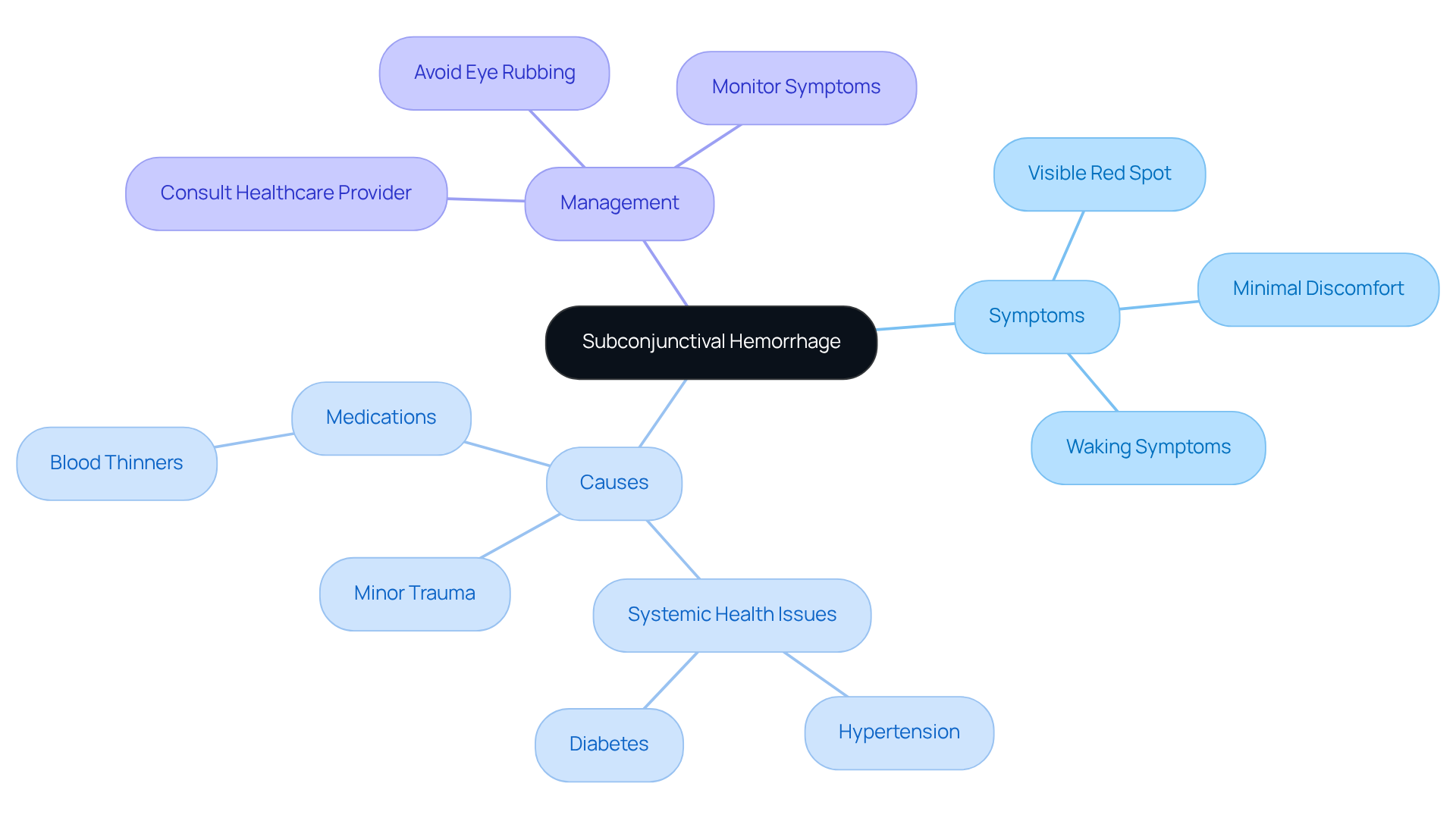
Eye Discomfort or Irritation: A Common Symptom of Subconjunctival Hemorrhage
Patients experiencing subconjunctival hemorrhage symptoms often describe a mild discomfort or irritation in the affected eye, which may feel like a scratchy sensation or slight tenderness. This condition typically presents as a unilateral red eye, which may include subconjunctival hemorrhage symptoms, often asymptomatic, but it can lead to mild irritation. While the symptoms of subconjunctival hemorrhage are generally not severe, they can be bothersome enough to encourage individuals to . It’s important to differentiate this discomfort from pain, as pain may indicate a more serious underlying issue.
We understand that the occurrence of non-traumatic subconjunctival bleeding can be concerning. According to a study, the mean annual occurrence is about 65 per 10,000 individuals, highlighting its prevalence, especially among cataract patients who may be at risk. Understanding these nuances can help you effectively communicate your subconjunctival hemorrhage symptoms to healthcare providers, ensuring appropriate evaluation and care.
As eye specialist Chia-Yi Lee points out, ‘The presence of DVDs may be a risk factor for the development of SCH,’ which underscores the importance of being aware of symptoms and potential underlying issues. The good news is that subconjunctival bleeding usually resolves within two weeks, offering reassurance regarding its self-limiting nature. Remember, we are here to help you through this process and provide the support you need.
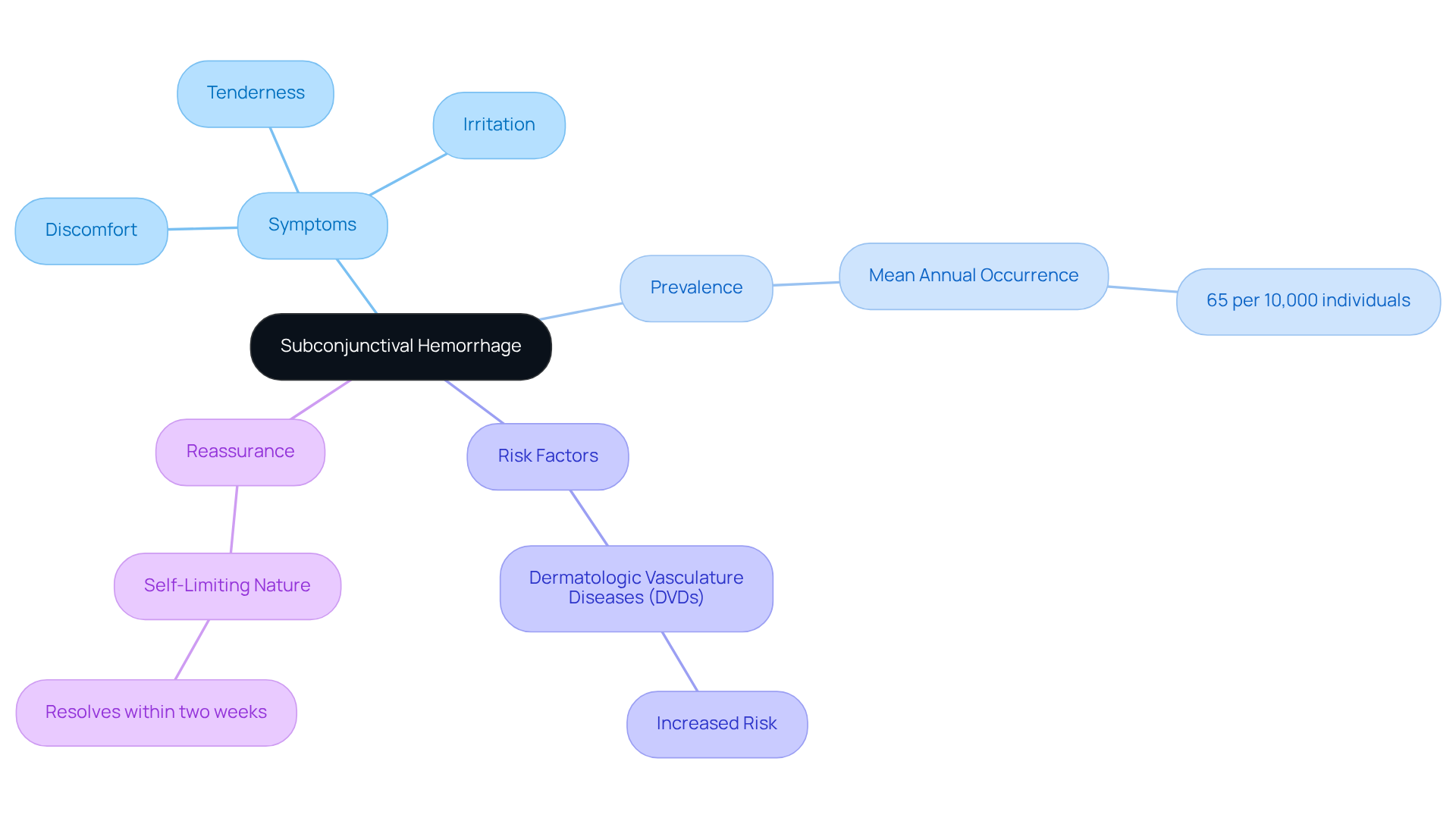
Blurred Vision: A Symptom That May Accompany Subconjunctival Hemorrhage
Blurred vision is not commonly associated with eye bleeding, but it can occur, especially in cases of significant bleeding. We understand that experiencing this symptom can be concerning, leading you to worry about a more serious eye condition. Notably, a study has shown that when eye bleeding coincides with vision changes, it raises alarms. This is because, while the bleeding itself usually does not affect visual sharpness, it may indicate potential harm to essential components of the eye.
Therefore, if you notice blurred vision alongside a visible red spot, it is crucial to seek prompt consultation with an eye care professional. This could signal underlying issues that require immediate attention. We are here to help you through this process, as is essential for preventing potential long-term vision damage.
Changes in Vision: Critical to Monitor with Subconjunctival Hemorrhage
As a patient, it is essential to observe subconjunctival hemorrhage symptoms, including any vision alterations following a conjunctival bleed. We understand that experiencing changes in your vision can be concerning. While most cases resolve on their own in about 2 to 3 weeks without complications, any sudden alterations—such as increased blurriness, double vision, or loss of vision—could indicate subconjunctival hemorrhage symptoms, which should prompt . These symptoms, including subconjunctival hemorrhage symptoms, may indicate serious underlying conditions such as retinal detachment or other ocular emergencies.
It’s important to know that untreated subconjunctival hemorrhage symptoms can lead to complications affecting vision, particularly for older individuals with pre-existing vascular disorders. In fact, the age-specific incidence of non-traumatic subconjunctival bleeding (NTSCH) peaks in the 60-69 age group. A comprehensive assessment is crucial, particularly if you are undergoing anticoagulant treatment, as this increases your risk for repeated bleeding episodes and related complications.
Consistent observation and swift response to changes in your vision can greatly influence your outcomes and ensure timely action for potentially serious issues. We encourage you to be proactive about your health. Furthermore, regular blood pressure assessments are advised for patients with eye bleeding to observe underlying health issues. Remember, we are here to help you through this process.
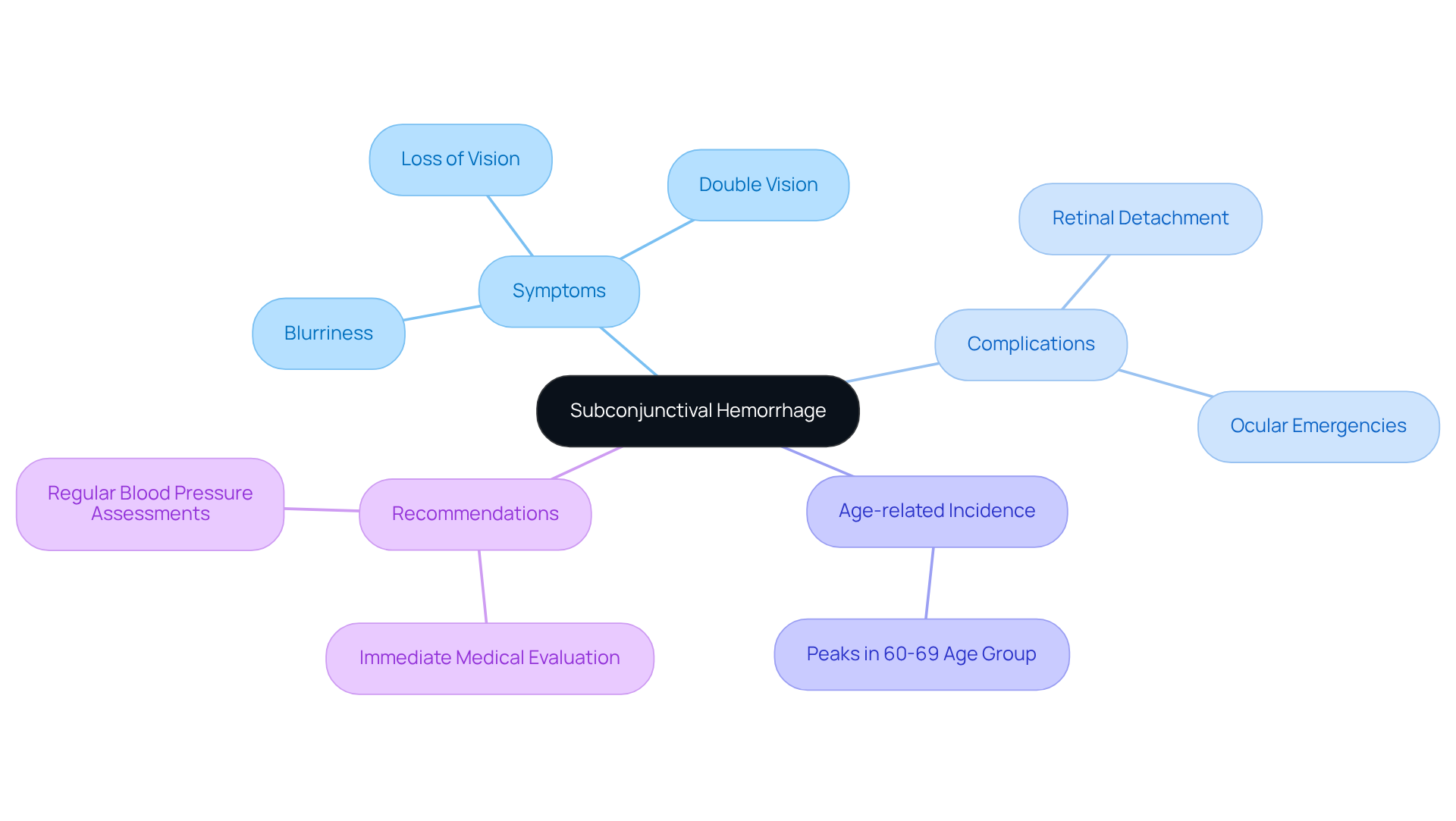
Eye Pain: A Symptom That Requires Attention in Subconjunctival Hemorrhage
While eye bleeding is typically painless, experiencing is a cause for concern that warrants prompt attention. We understand that such symptoms can be alarming, as they may indicate underlying issues like corneal abrasions or infections. Research shows that corneal abrasions are common among individuals with red spots on the eye, reinforcing the importance of a thorough assessment.
It’s common to feel anxious, especially knowing that over 5 million people seek medical attention for eye pain each year. This statistic highlights the seriousness of this symptom. Eye care professionals emphasize that timely intervention is crucial not only for effective pain management but also to prevent potential vision loss.
If you find yourself facing eye discomfort along with subconjunctival hemorrhage symptoms, please don’t hesitate to reach out to your eye care expert. We are here to help you through this process and ensure you receive the care you need.
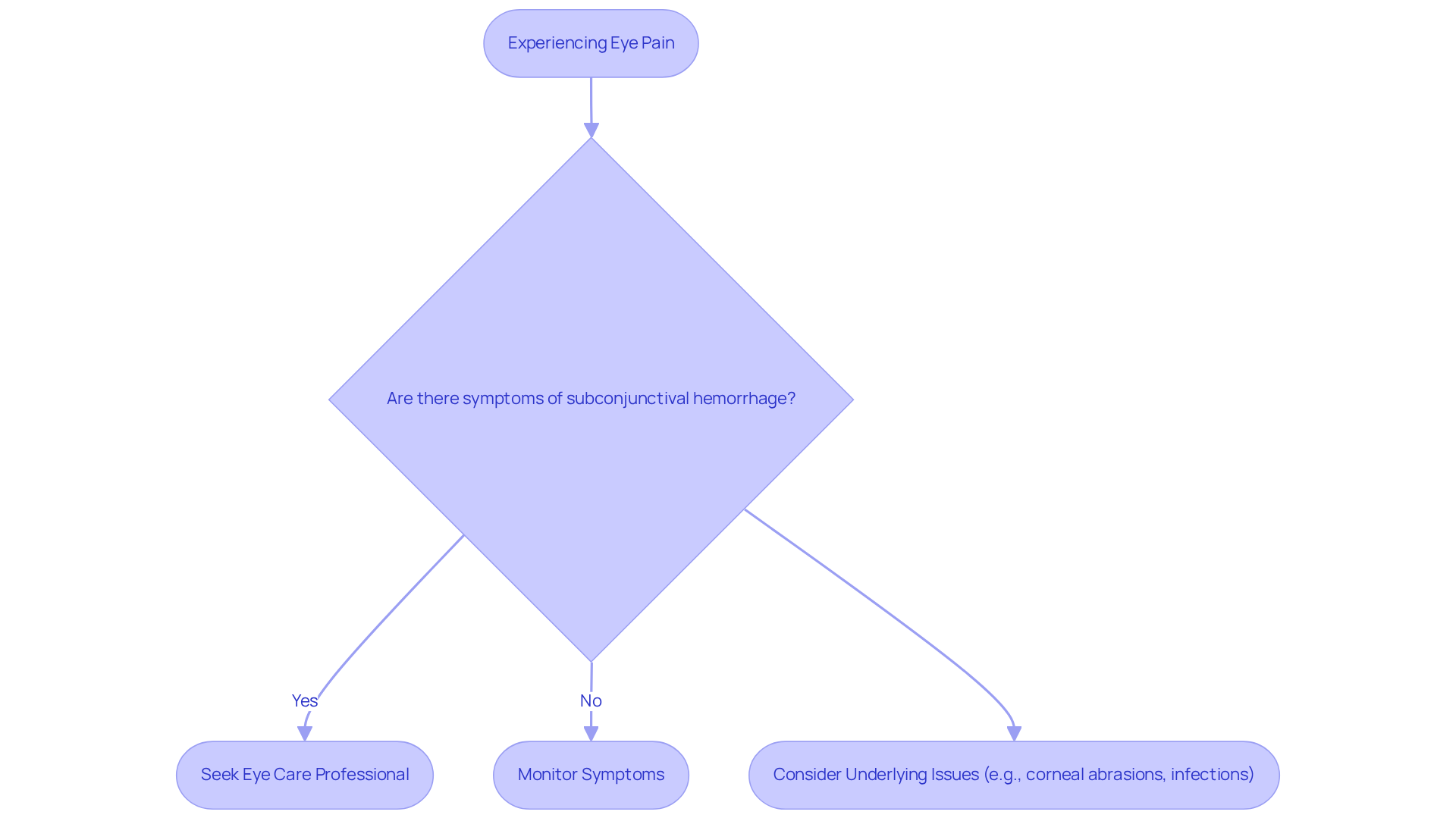
Swelling Around the Eye: A Notable Symptom of Subconjunctival Hemorrhage
Swelling around the eye is a common sign associated with subconjunctival hemorrhage symptoms, particularly after an injury or irritation. We understand that this can be concerning. The severity of swelling can vary, being either localized or more extensive, depending on the extent of bleeding and any accompanying injuries.
Reports indicate that the symptoms of subconjunctival hemorrhage occur in around 52% of patients with ocular trauma, highlighting its prevalence in such cases. It’s important to monitor any swelling closely, as significant changes may indicate complications that require prompt attention. Ophthalmologists emphasize this necessity, reassuring patients that they are not alone in their concerns.
Dr. Nedime Sahinoglu-Keskek notes that the fragility of conjunctival vessels can lead to bleeding. We encourage patients to inform their eye care provider about any significant changes in swelling. This proactive communication ensures and effective management of their condition.
Significantly, the age group most affected by eye bleeding falls between 27.5 and 32.6 years. This information may resonate with many patients, and we are here to help you through this process, providing the support you need.
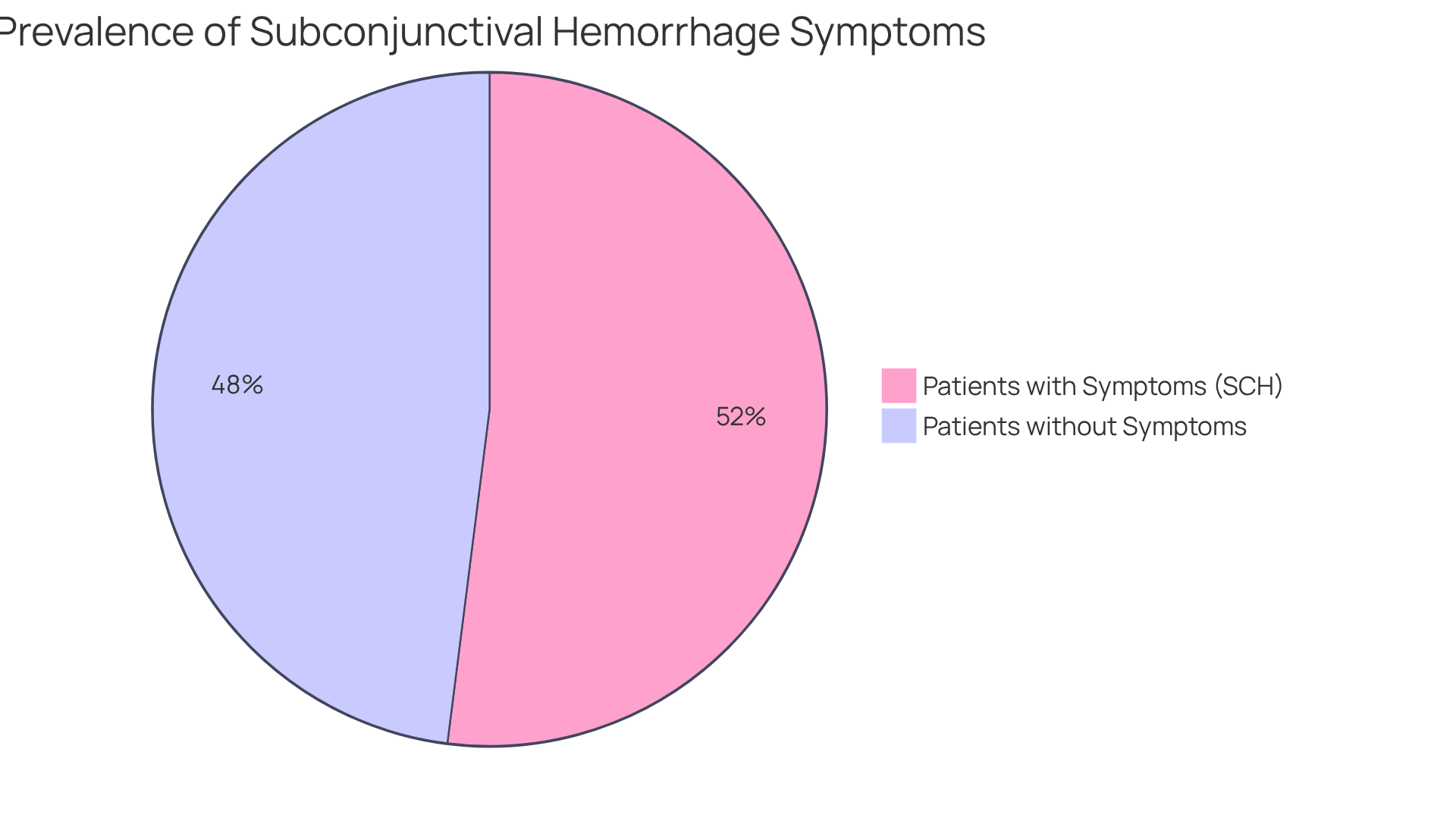
Recurrent Subconjunctival Hemorrhages: Understanding the Risk Factors
Repeated eye bleeding episodes, recognized as subconjunctival hemorrhage symptoms, can understandably be a source of worry. They often indicate underlying health issues such as hypertension, blood clotting disorders, or the use of anticoagulant medications. We understand that , with hypertension being a predominant cause of SCH in this demographic. Additionally, blood disorders, such as Von Willebrand disease and immune thrombocytopenia, can increase the fragility of blood vessels, leading to these recurrent episodes. It’s important to note that up to 40% of SCH cases have an unknown cause, highlighting the unpredictability of this condition.
If you are experiencing repeated subconjunctival hemorrhage symptoms, we encourage you to consult your healthcare provider. This is essential to assess potential risk factors and discuss necessary interventions. For instance, a case study revealed that recurrent SCH could be a symptom of ocular amyloidosis, where amyloid deposits weaken blood vessel walls, increasing the risk of rupture. Furthermore, the use of systemic anticoagulants, such as warfarin, has been linked to a higher incidence of SCH, especially after surgery. In fact, the incidence of SCH during sub-Tenon’s anesthesia has been reported to range from 7% to 56%, indicating its prevalence in surgical settings.
Healthcare professionals emphasize the importance of monitoring blood pressure and conducting thorough evaluations for patients with recurrent episodes. As one specialist wisely noted, ‘If you experience discomfort along with the red spot, or if you have recurring instances of eye bleeding that may suggest subconjunctival hemorrhage symptoms, consult your healthcare provider.’ This serves as a reminder to stay alert for serious underlying issues that may require further examination. Overall, understanding these risk factors is crucial for effective management and ensuring optimal eye health. Most eye bleeding events clear up on their own within two weeks, which can be reassuring for patients.
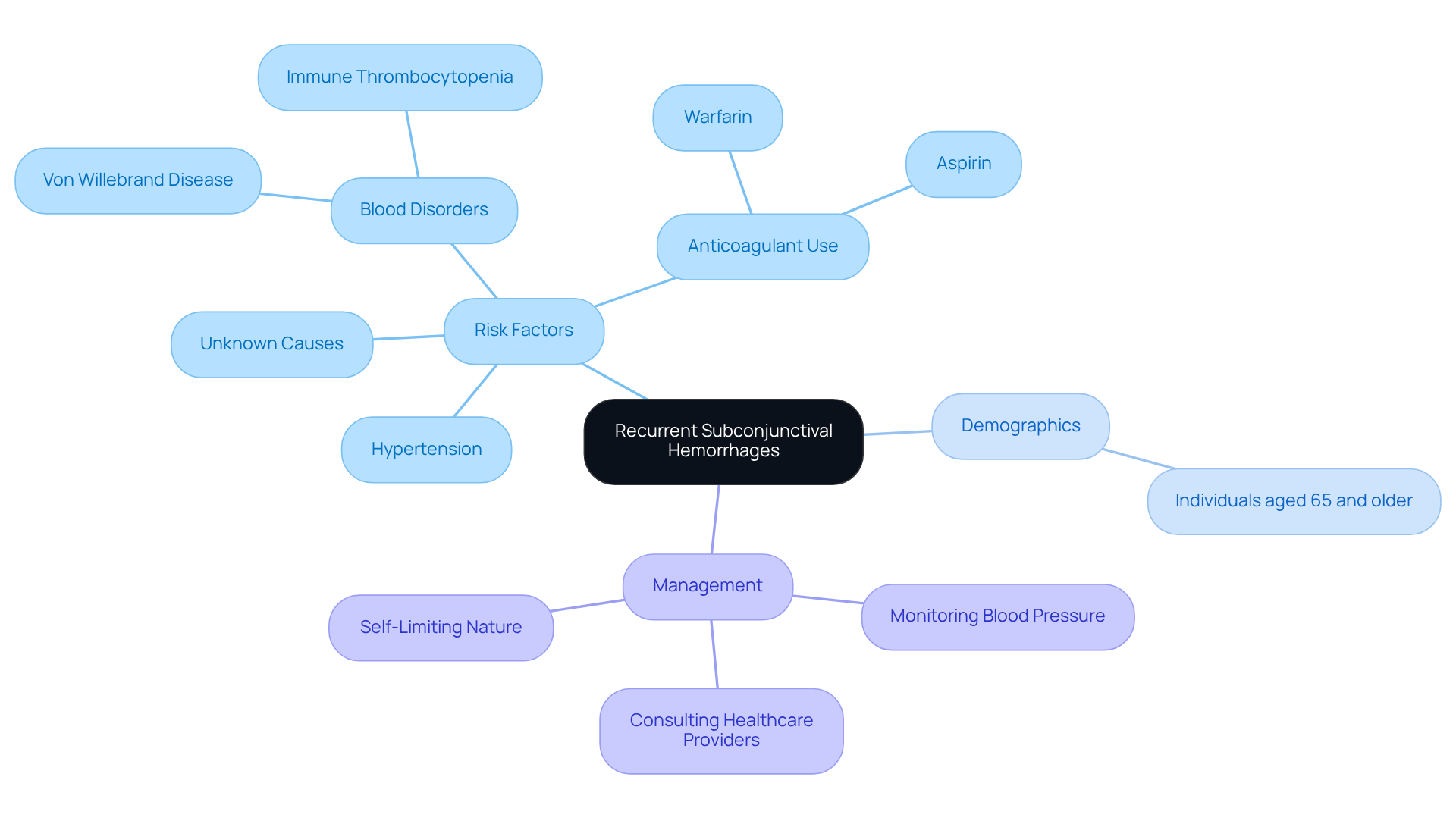
Underlying Health Conditions: Factors Influencing Subconjunctival Hemorrhage Symptoms
Specific underlying health issues, such as diabetes, hypertension, and blood clotting disorders, can elevate the chances of eye bleeding. We understand that managing these conditions can be challenging, and it’s essential for patients to be . If you notice any subconjunctival hemorrhage symptoms, it is important to report them to your healthcare provider. Regular monitoring and management of these systemic issues can significantly reduce the risk of developing subconjunctival hemorrhage symptoms and other eye-related complications.
It’s comforting to know that the majority of instances of eye bleeding resolve on their own within two weeks. In Canada, a report highlighted that 11% of the population has diabetes, underscoring its prevalence and implications for eye health. Additionally, individuals who have undergone eye surgery, such as cataract procedures, may face a higher risk of bleeding under the conjunctiva. If you wear contact lenses, it’s important to be aware that this can also increase your chances of experiencing this issue.
We recognize that eye bleeding can occur sporadically, with a 10% chance of reappearing even in individuals without identified risk factors. Therefore, we encourage you to remain proactive in monitoring your eye health. Remember, we are here to help you through this process.

Seek Medical Evaluation: When to Consult a Specialist for Subconjunctival Hemorrhage
If you are experiencing significant eye pain, vision changes, or symptoms of subconjunctival hemorrhage such as a red spot that doesn’t improve within two weeks, we understand how concerning this can be. It’s important to seek medical evaluation promptly if you notice any subconjunctival hemorrhage symptoms. For those who have faced repeated eye bleeding or have underlying health issues, such as hypertension or blood clotting disorders, recognizing the subconjunctival hemorrhage symptoms and reaching out to an eye care expert for a comprehensive evaluation is essential.
The occurrence of eye bleeding during sub-Tenon’s anesthesia has been noted to range from 7% to 56%. This statistic highlights how prevalent this ailment can be, and we want you to know that early intervention is crucial. It can help identify potential complications and safeguard your optimal eye health.
Ophthalmologists emphasize that timely consultations can significantly impact treatment outcomes. We encourage you to be vigilant in monitoring your eye symptoms. Many patients have shared their experiences where proactive interaction with eye care specialists led to improved management of eye bleeding and related conditions.
Additionally, if you are presenting with subconjunctival hemorrhage symptoms, monitoring your blood pressure is essential. Elevated levels can indicate underlying issues that require attention. Remember, we are here to help you through this process and support you in achieving the .

Conclusion
Recognizing the symptoms of subconjunctival hemorrhage is crucial for maintaining your eye health and addressing any underlying issues. You might notice a distinctive red spot on your eye, mild discomfort, blurred vision, or swelling—these can all serve as indicators of this condition. Understanding these signs empowers you to seek timely medical evaluation, ensuring that any serious complications are addressed promptly.
We understand that while subconjunctival hemorrhage often resolves on its own, awareness of recurrent episodes and associated risk factors—such as hypertension and blood clotting disorders—is essential. It’s common to feel concerned about your symptoms, and we encourage you to monitor them closely. Consulting with your healthcare provider is important, especially if you experience significant discomfort or changes in your vision.
Ultimately, proactive engagement in your eye health can lead to better outcomes and peace of mind. If you experience symptoms of subconjunctival hemorrhage, please don’t hesitate to reach out to eye care specialists for guidance and support. By staying informed and vigilant, you can effectively manage your eye health and address any concerns that arise.
Frequently Asked Questions
What is subconjunctival hemorrhage?
Subconjunctival hemorrhage is characterized by a vivid red patch on the sclera (the white part of the eye) that occurs when tiny blood vessels rupture, allowing blood to seep into the conjunctival space.
What are the common symptoms of subconjunctival hemorrhage?
The primary symptom is a visible red spot on the eye. Patients may also experience mild discomfort or irritation in the affected eye, which can feel scratchy or tender. However, it usually does not affect vision.
What causes subconjunctival hemorrhage?
Common causes include minor trauma, systemic health issues such as hypertension and diabetes (especially in individuals over 50), and certain medications that affect blood clotting.
How long does subconjunctival hemorrhage last?
Subconjunctival hemorrhage often resolves on its own within one to four weeks.
Should I be concerned about recurrent subconjunctival hemorrhage?
If you experience recurrent eye bleeding, it is advisable to consult with your healthcare provider for a thorough assessment, which may include a referral to internal medicine to address any underlying health issues.
When should I seek medical advice for subconjunctival hemorrhage?
You should seek medical advice if you experience significant discomfort, pain, or if the condition persists beyond a few weeks, as pain may indicate a more serious underlying issue.
Is subconjunctival hemorrhage serious?
Subconjunctival hemorrhage is usually harmless and does not affect vision, but it can be concerning. Understanding the condition and its causes can help manage it effectively.
What is the prevalence of subconjunctival hemorrhage?
The mean annual occurrence of non-traumatic subconjunctival hemorrhage is about 65 per 10,000 individuals, particularly prevalent among cataract patients who may be at risk.






